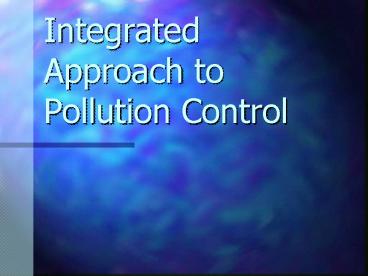Integrated Approach to Pollution Control PowerPoint PPT Presentation
1 / 15
Title: Integrated Approach to Pollution Control
1
Integrated Approach to Pollution Control
2
Outline
- Introduction Putting all together
- Cumulative effects
- NEPA standards
- Tools and Techniques
- Planning, EIA, EIS
- Compliance and Monitoring
- Strategic Management Approach
- Participatory Environmental Management
- Managing Environmental Change
3
Introduction Putting all together
- Technical aspects
- Problem issues and management concerns
- Thematic Issues
- Air
- Water
- Clean up
- Waste
- Industry Specific
- Special Pollutants
- Permits and permitting process
- Regulations and standards
- Notices
- Worksheets
- Review Process
- Federal register http//www.epa.gov/fedrgstr/
- Monitoring and Reporting
- Example
- See what is your EPA doing
- http//www.epa.state.il.us/
- http//www.pca.state.mn.us/siteindex.html
4
Cumulative effects
- NEPA standards and regulations
- Tools and Techniques
- Planning, EIA, EIS
- Appraisal of alternatives
5
NEPA Guidelines
- NEPA 1969
- CONGRESSIONAL DECLARATION OF NATIONAL
ENVIRONMENTAL POLICY - COUNCIL ON ENVIRONMENTAL QUALITY
- Refer Appendix A
- Topics of EIS
- Status of Environment
- Description of proposed Project
- Env Assessment
- Unavoidable Adverse Env impacts
- Secondary or indirect impacts
- Methods of reducing adverse impacts
- Alternatives to proposed project
- Irreversible commitments of energy and resources
- Consideration of public input and review
6
Tools and Techniques
- Bringing science to EIA and EIS
- See separate hand out
7
Tools and Techniques
- Questions, Interviews and Panels (Peoples
expectations) - Checklists (Potential impact areas in Columns
Activities in rows) - Matrices
- Network Analysis and Diagrams
- Modeling
- Trend analysis (baseline)
- Overlay Mapping and GIS
- Carrying Capacity Analysis
- Ecosystem Analysis
- Economic Impact Analysis
8
Cumulative Effects Analysis Steps
- Describing affected Environment
- Use natural boundaries
- Focus on each affected resources, processes,
ecosystem and human activity - Determine Env Consequences
- Address additive, countervailing and synergistic
impacts - Look beyond project time line
- Address long-term sustainability and stewardship
of the whole environment
- Scoping
- Embrace past present future
- Focus on each affected resource, processes,
ecosystem and human activity - Focus on truly meaningful effects
9
Cumulative Effects Analysis Steps
- Describing affected Environment
- Characterize resources, ecosystems and human
communities from scoping - Characterize their stresses and their relation to
regulatory thresholds - Define baseline conditions for resources,
ecosystems and human activities - Determine Env Consequences
- Identify cause-effect relationship
- Determine magnitude and significance of
cumulative effects - Modify or add alternatives for mitigation
- Monitor and follow adaptive management
- Scoping
- Identify issues
- Establish geographic Scope
- Establish Time frame
- Identify other concerns affecting resources,
processes, ecosystems and human dimension
10
Compliance and Monitoring
- Polluter pays principle
- EIA and EIS
- Review and Audits
11
Strategic Management Approach
- Mission
- Vision
- Results and deliverables
- Activities
- Business like delivery approach
12
Strategic Management Approach
- Strategic Issues
- Identification
- Prioritization
- Choices
- Formulation of Strategic Plan
- Mission, Goal, Objectives
- Strategies
- Action Plan
- Strategic Planning and Management
- General Lessons Learned
- Institutional Analysis
- Objectives
- Logframe
- SWOT
- Stakeholders analysis
13
Participatory Environmental Management
- Present Trends
- Notice of Intent
- Notice of availability
- Notice of Availability and Public hearing
- Ideal approach
- Stake holder identification
- Group planning
- SWOT (strength, weakness, Opportunity and
Threats) - Reaching a consensus
- Put people before technology
14
Managing Environmental Change
- Manage cumulative Effects
- Link Present with Past
- Make a future desired condition
- Ensure monitoring (EMAP) and reporting
- Example http//www.pca.state.mn.us/hot/legis
lature/reports/index.html - Enforcement is also an integral part
- Eg. http//www.epa.state.il.us/cgi-bin/en/orders/o
rders.pl - Be forceful in justification and rationale
15
Further reading
- http//ceq.eh.doe.gov/nepa/ccenepa/ccenepa.htm
- http//tis.eh.doe.gov/nepa/
- http//ceq.eh.doe.gov/nepa/regs/nepa/nepaeqia.htm
- http//www.pca.state.mn.us/siteindex.html
- http//www.whitehouse.gov/ceq/

